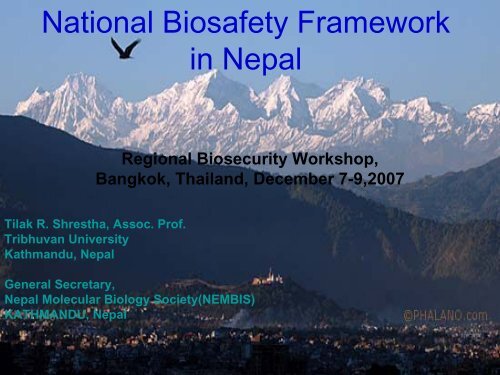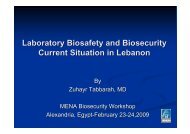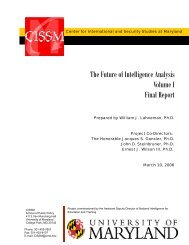Biosecurity: Status and Policy in Nepal - Center for International and ...
Biosecurity: Status and Policy in Nepal - Center for International and ...
Biosecurity: Status and Policy in Nepal - Center for International and ...
Create successful ePaper yourself
Turn your PDF publications into a flip-book with our unique Google optimized e-Paper software.
National Biosafety Framework<br />
<strong>in</strong> <strong>Nepal</strong><br />
Regional <strong>Biosecurity</strong> Workshop,<br />
Bangkok, Thail<strong>and</strong>, December 7-9,2007<br />
Tilak R. Shrestha, Assoc. Prof.<br />
Tribhuvan University<br />
Kathm<strong>and</strong>u, <strong>Nepal</strong><br />
General Secretary,<br />
<strong>Nepal</strong> Molecular Biology Society(NEMBIS)<br />
KATHMANDU, <strong>Nepal</strong>
Country Background<br />
• South of Himalayan Range<br />
• Between Ch<strong>in</strong>a <strong>and</strong> India<br />
• Area 1,47,181sq.km<br />
• Elevation 60 m to 8848m-Mt. Everest<br />
• Hills <strong>and</strong> high mounta<strong>in</strong>-86%<br />
• Terai pla<strong>in</strong>-14% of total area of nation
Biological Diversity<br />
Climatic Diversity<br />
Peculiar Geographical<br />
Structure<br />
Climatic diversity- Diversity <strong>in</strong> habitat, plants <strong>and</strong> animals<br />
Seasonal variation-ra<strong>in</strong>s <strong>in</strong> monsoon, snowfall <strong>in</strong> w<strong>in</strong>ter, high temt. <strong>in</strong> summer<br />
One season- different climate <strong>in</strong> different l<strong>and</strong>scape of nation<br />
This is one of the reason <strong>for</strong> species diversity
Species Diversity<br />
Species Diversity differs with elevation of <strong>Nepal</strong><br />
High Mounta<strong>in</strong> – above 3000m<br />
- Covers 78.52% of total area,<br />
- 38 ecosystems <strong>in</strong> this region<br />
The middle hill region-1000 to 3000m above sea level<br />
- Biodiversity rich areas- 32% of total <strong>for</strong>est,<br />
- Terai-Siwalik range- 60 to 1000m- imporatnt ecosystem<br />
- 5 protected areas <strong>in</strong> this region <strong>for</strong> world’s endangered species<br />
- Chitawan National Park – World heritage site
1-Biodiversity:<br />
• <strong>Nepal</strong> Geographically small but rich <strong>in</strong> biodiversity<br />
• <strong>Nepal</strong> represents-0.1% of terrestrial area of the earth but<br />
• Has 118 ecosystem, higher presence of diff. flora <strong>and</strong> fauna<br />
• 15 sps. of vascular plants, 58 sps. of mammals, 40 sps. of<br />
birds,<br />
• 13 sps. of reptiles, 2 sps. of <strong>in</strong>sects <strong>and</strong> 1 sps. of amphibian<br />
belons to CITES list.<br />
• 342 plant sps & 160 animal sps. are Endemic to <strong>Nepal</strong><br />
• Biodiversity closely l<strong>in</strong>ks to –<br />
• <strong>Nepal</strong>ese livelihoods, economic development, agricultural<br />
system, human health <strong>and</strong> prote<strong>in</strong>, construction material, water<br />
resource & society’s cultural values.<br />
• Source: <strong>Nepal</strong> Biodiversity Strategy (NBS), 2002
<strong>Nepal</strong>’s richness <strong>in</strong> Organism as Compared to the World<br />
Gr. Of Organism<br />
Lichens<br />
Fungi<br />
Algae<br />
Bryophytes<br />
Pteridophytes<br />
Gymnosperm<br />
Angiosperm<br />
Spider<br />
Other <strong>in</strong>sects<br />
Butterflies & Moths<br />
Birds (>850sps)<br />
Reptiles<br />
Amphibians<br />
Fishes<br />
Mammals<br />
Sources:NBS, 2002<br />
<strong>Nepal</strong>’s representation as compared to<br />
the no. of species <strong>in</strong> the world<br />
2.3<br />
2.4<br />
2.6<br />
5.1<br />
3.4<br />
5.1<br />
2.7<br />
0.2<br />
0.7<br />
2.6<br />
9.3<br />
1.6<br />
1.0<br />
1.0<br />
4.5
<strong>Nepal</strong>’s biosafety policy is based on<br />
precautionary pr<strong>in</strong>ciple:<br />
• And based on conservation of rich<br />
biodiversity<br />
• Protective measures <strong>for</strong> <strong>in</strong>digenous<br />
agricultural system<br />
• Srict regulation on GMO, LMO & Hybrid & its<br />
transboundary movement<br />
• But less attention on pathogen, microorganism<br />
& possible bioterrorism<br />
• Development & application of Biotechnology where<br />
comparative benefits can be achieved.
<strong>Nepal</strong>’s <strong>in</strong>ternational obligation<br />
• Commitment to Biosafety by Sign<strong>in</strong>g the Cartagena Protocol- 2 nd March<br />
2002<br />
• To pay attention to transboundary movement of GMOs, on the basis of<br />
advanced <strong>in</strong><strong>for</strong>med agreement.<br />
• Laws <strong>and</strong> policies related to the release, use <strong>and</strong> market<strong>in</strong>g of GMOs<br />
have to be <strong>for</strong>mulated as per the provision of the Cartagena Protocol.
2:<strong>Policy</strong> Aspects of Biosafety <strong>in</strong> <strong>Nepal</strong><br />
1- Sustenable Development Agenda 2003<br />
2- Millenium Development Goals (MDGs) 2000<br />
3- The Tenth Plan (2002 – 2007)-stress on biotech, bioeng. & biosafety.<br />
4- <strong>Nepal</strong> Biodiversity Strategy, 2002<br />
5- <strong>Nepal</strong> Biodiversity Strategy Implementation Plan(NBSIP)-2006-07<br />
6- National Wetl<strong>and</strong> <strong>Policy</strong>, 2002<br />
7- Science & Technology <strong>Policy</strong>, 2002<br />
8- Biotechnology <strong>Policy</strong>, 2006<br />
9- Biosafety Guidel<strong>in</strong>es, 2005 by M<strong>in</strong>st. Of Forest & soil Conservation<br />
10- Agricultural <strong>Policy</strong>, 2005<br />
11- National Seed <strong>Policy</strong>, 1997<br />
12-National Biosafety <strong>Policy</strong>, March 1, 2007
Legal provisions relat<strong>in</strong>g to biosafety<br />
Although not specific, many legal provisions are found to have <strong>in</strong> place long be<strong>for</strong>e<br />
the emergence of the concept of biosafety itself.<br />
1- Local self governance act 1999.<br />
2- Consumer protection act, 1997<br />
3- The export import act, 1956<br />
4- Plant protection act, 1972<br />
5- Seed act, 1989<br />
6- Food act, 1966<br />
7- Feed act, 1966<br />
8- Animal health & livestock service act, 1998<br />
9- Slaugheter house <strong>and</strong> meat <strong>in</strong>spection act, 1999<br />
10- National dairy development board act. 1991<br />
11- <strong>Nepal</strong> agricultural research council act, 1991<br />
12- Drug act, 1978<br />
13- National park <strong>and</strong> conservation act, 1972<br />
14- Forest act, 1999<br />
15- Aquatic animal protection act 1960<br />
16- Environmental protection act, 1997<br />
17- The patent, design <strong>and</strong> trademark act, 1965
The Proposed Legal Frame Work <strong>for</strong> Biosafety<br />
• Function is to make biosafety bill with the follow<strong>in</strong>g provisions:<br />
1- Objectives<br />
2- Scope<br />
3- Def<strong>in</strong>itions<br />
4- Institutional set up (MFSC as national focal po<strong>in</strong>t & NBC-national biosafety committee)<br />
representation from different sectors<br />
5- Proposal Submission with Risk assessment & Management Report<br />
6- Environmental Impact Assessment (EIA)<br />
7- Public hear<strong>in</strong>g<br />
8- Decision on proposal<br />
9- Determ<strong>in</strong>ation of biosafety st<strong>and</strong>ard<br />
10- Packag<strong>in</strong>g <strong>and</strong> labell<strong>in</strong>g<br />
11-Monitor<strong>in</strong>g, <strong>in</strong>spection <strong>and</strong> emergency response<br />
12- protection of confidential <strong>in</strong><strong>for</strong>mation<br />
13- Declaration of GMOs Free Zone<br />
14- Provision of biosafety officer, 15- Offences & penalties,<br />
16- Biosafety fund, 17- Capacity build<strong>in</strong>g
3-Technical Aspects of Biosafety<br />
3.1-Technical frame work covers<br />
A- The scientific research<br />
B- Test<strong>in</strong>g of seed, plants, food, feed <strong>and</strong> animals with<br />
GMOs which may be imported or produced with<strong>in</strong><br />
the country<br />
C- identification, characterization <strong>and</strong> analysis of the<br />
components of GMOs<br />
D- Decision mak<strong>in</strong>g <strong>for</strong> import <strong>and</strong> export.<br />
E- management of risk
3.2- Potential Risk as mentioned <strong>in</strong> the policy<br />
A- Potential risks of plants GMOs <strong>and</strong> their product<br />
I- Expression of toxic or allergenic compound<br />
II- Effects on biogeochemistry<br />
III- Transfer of disease resistant, <strong>in</strong>sect pest resistant, herbicide<br />
resistant genes to wild species, cultivated or domesticated wild<br />
or semi wild sps.<br />
IV- Transfer of genetic material(bacterial, fungal, viral) i.e. gene<br />
flow via poll<strong>in</strong>ation to wild, cultivated or domsticated.<br />
V- Instabilty of genetic modification<br />
VI- Un<strong>in</strong>tended genetic modification to adverse effects<br />
VII- Issues of impacts of new traits on target & non target<br />
organism
B-Potential risk of genetically modified<br />
Micro-organisms<br />
I- Diseases of human & animal, toxic or allergenic<br />
effects<br />
II- Epidemic <strong>in</strong> agricultural <strong>and</strong> natural environment<br />
III- Adverse effect from <strong>in</strong>stabilty to treat diseasea<br />
IV- Adverse effects to ecolgical & biogeochemical cycle<br />
result<strong>in</strong>g from GMOs <strong>in</strong>troduction<br />
V- Adverse effects result<strong>in</strong>g from natural transfer of<br />
<strong>in</strong>serted genetic materials to other organism
C-Potential risk of genetically modified<br />
animals & product<br />
I- Adventitious <strong>in</strong>fectious agent transfer<br />
II- Endogenous retroviral activation<br />
III- Entopic expression of transgene (<strong>in</strong> non target tissues)<br />
IV- Excess production of transgene or metabolites<br />
V- Pleiotropic effects of transgene expression (unpredicted<br />
effects on the expression of other genes<br />
VI- Prion disease susceptibility hazards<br />
VII- Leakage of expressed products from target tissues
3.3 Need of Technical Framework<br />
Technical management <strong>for</strong> risk identification:<br />
A- Prior to permitt<strong>in</strong>g release of GMO, the GMO <strong>in</strong> question should subject to<br />
an adequate period of observation, at least to its life cycle or generational<br />
time.<br />
B- GMOs package & products need to have labell<strong>in</strong>g with general <strong>in</strong><strong>for</strong>mation<br />
on GMOs <strong>and</strong> potential allergenic<br />
C- Application of accepted risk management by different countries & its risk<br />
level:<br />
I- physical- (separation of areas <strong>for</strong> GMO test)<br />
II- chemical- (sterilization of the used <strong>in</strong>struments & media)<br />
III- biological- (establishment of biological buffer areas)<br />
D- To ban certa<strong>in</strong> products ( marked with antibiotic resistance)<br />
E- To prohibit certa<strong>in</strong> activities or work <strong>for</strong> risk avoidance<br />
F- Application of emergency measures
3.4 Exist<strong>in</strong>g situation:<br />
Technology, Human resources <strong>and</strong> Infra structure<br />
A- Biotech. lab, Tissues culture lab, Parasitological & Microbiology lab with PCR<br />
mach<strong>in</strong>e<br />
B- Human resources available <strong>in</strong> Plant <strong>and</strong> Animal Mol. Biology, Tissue culture,<br />
microbial Mol. Ecology, Forensic.<br />
C- Engaged <strong>in</strong> research & development activities<br />
D- Plant Biotech:- Tissues culture- Potato, Banana, Citrus <strong>and</strong> Flowers<br />
E- Disease diagnosis, genetic diversity study, biofertilizer, microbial bio-pesticides,<br />
livestock vacc<strong>in</strong>e (anti rabies), embryo transfer <strong>in</strong> livestock,<br />
F- Private sectors:- <strong>in</strong>volved <strong>in</strong> Tissue culture technology <strong>in</strong> agriculture &<br />
horticulture.<br />
G- Government sectors: NARC, NAST, CVL, <strong>Nepal</strong> Forensic Lab(<strong>for</strong> DNA<br />
f<strong>in</strong>gerpr<strong>in</strong>t<strong>in</strong>g)<br />
H- Available technical human resources are not enough<br />
<strong>for</strong> National Biosafety Program
3.5 Proposed Technical Framework<br />
A- Biosafety lab: Exist<strong>in</strong>g microbiology lab will be developed as<br />
reference lab check<strong>in</strong>g & verify<strong>in</strong>g proponents’s <strong>in</strong><strong>for</strong>mation on<br />
GMO.<br />
B- Risk exam<strong>in</strong>ation & management by SECTORAL COMPETENT<br />
AUTHORITY<br />
C- Capacity build<strong>in</strong>g-<br />
I- of <strong>in</strong>stitution <strong>for</strong> biosafety related R & D.<br />
II- of central to district level <strong>in</strong>stitution <strong>for</strong> Risk assessment &<br />
management.<br />
III- <strong>in</strong> GMO detection techniques<br />
IV- rDNA safety guidel<strong>in</strong>es<br />
V- Improv<strong>in</strong>g Quarant<strong>in</strong>e offices<br />
VI- Development of technical guidel<strong>in</strong>es <strong>for</strong> GMO & products<br />
VII- <strong>in</strong> labell<strong>in</strong>g GMOs<br />
VIII-Develop Biosafety Technology
4: Adm<strong>in</strong>istrative Aspects <strong>for</strong> Biosafety<br />
Decision mak<strong>in</strong>g <strong>and</strong> implementation mechanism<br />
National Competent Authority<br />
Secretariat<br />
Research <strong>Center</strong><br />
For Accredited Lab<br />
Sectoral Competent Authority<br />
Dept. of Agriculture<br />
Dept. of Food Tech & Quality Controle<br />
Dept. of Livestock Development<br />
Seed quality controle center<br />
Dept. of Plant Resources<br />
Dept. of Drug Adm<strong>in</strong>istration<br />
Dept.of<br />
Commerce<br />
Dept. of<br />
Custom<br />
Quarant<strong>in</strong>e<br />
Office<br />
Inter-l<strong>in</strong>kage among the <strong>in</strong>stitutions <strong>in</strong>volved <strong>in</strong> the decision<br />
mak<strong>in</strong>g process <strong>in</strong> biosafety
Proponents’ proposal submission with risk assessment & management report to NCA<br />
Public comments on the proposal<br />
Total duration of the action is 270 days<br />
Screen<strong>in</strong>g the proposal <strong>and</strong> ask <strong>for</strong> further <strong>in</strong><strong>for</strong>mation if required<br />
Send the proposal & the assessment report to SCA <strong>for</strong> review & evaluation<br />
SCA-> Public hear<strong>in</strong>g, reviews, exam<strong>in</strong>es <strong>in</strong> accredited lab, submit to NCA<br />
The NCA makes the decision<br />
Notification to proponent, SCA, Dept. of Commerce, custom, Quarant<strong>in</strong>e,BCH about decision made<br />
Monitor<strong>in</strong>g of approved proposal<br />
Improvement <strong>in</strong> the decision, implementation accord<strong>in</strong>g to monitor<strong>in</strong>g report<br />
Flow chart of a decision mak<strong>in</strong>g <strong>and</strong> implementation of a proposal on GMOs or its products
Gaps <strong>in</strong> <strong>Nepal</strong>’s National Biosafety Frame<br />
Work <strong>and</strong> Lesson from Developed<br />
Countries <strong>for</strong> Dual Use & Pathogen &<br />
Micro-organisms
<strong>International</strong> Collaboration<br />
1.Global Health Alert Network<br />
Global <strong>Biosecurity</strong> Action Group Net<br />
2.Global <strong>Biosecurity</strong> Laboratory Net<br />
3.WHO, US CDC, Pasteur Institute, Ch<strong>in</strong>a &<br />
Korea CDC, Taiwan CDC <strong>and</strong> other <strong>for</strong>eign<br />
National Health Institutes
to be done now<br />
;CISSM
Regulation on the Safety Control<br />
of Laboratories H<strong>and</strong>l<strong>in</strong>g<br />
Pathogenic Agents, A lesson from<br />
NIID, Japan <strong>and</strong> other Develop<strong>in</strong>g<br />
Nations,<br />
1.Risk Classification of microbiological agents<br />
2.Relation of risk groups to biosafety levels,<br />
practices <strong>and</strong> equipment<br />
3.Facility requirements at the four biosafety<br />
levels
Safety Organization <strong>and</strong> Tra<strong>in</strong><strong>in</strong>g<br />
<br />
<br />
<br />
Biosafety Office (permanent <strong>and</strong> temporary staffs):<br />
Responsible <strong>for</strong> all issues on biosafety <strong>and</strong><br />
biosecurity<br />
Tra<strong>in</strong><strong>in</strong>g Course : bimonthly,<br />
Report<strong>in</strong>g System:<br />
Material Transfer Agreement,<br />
Permission <strong>and</strong> report<strong>in</strong>g of pathogen<br />
<strong>for</strong> h<strong>and</strong>l<strong>in</strong>g, transfer, acceptance, etc.<br />
Report<strong>in</strong>g on accident <strong>in</strong> the laboratory.<br />
Other issues
4.Biosafety Guidel<strong>in</strong>es<br />
1). Risk assessment<br />
2). Basic laboratory BSL-1, 2<br />
3). Conta<strong>in</strong>ment laboratory BSL-3<br />
4). The maximum conta<strong>in</strong>ment laboratory BSL-4<br />
*All laboratories should have the own operation manual<br />
5). Laboratory animal facilities ABSL-1 to 4<br />
6). Guidel<strong>in</strong>es <strong>for</strong> laboratory certification<br />
•Source: Takeshi KURATA , 2007,<br />
•Regional <strong>Biosecurity</strong> workshop, S<strong>in</strong>gapore
Source: Takeshi KURATA , 2007,<br />
Regional <strong>Biosecurity</strong> workshop, S<strong>in</strong>gapore
Source: Takeshi KURATA , 2007,<br />
Regional <strong>Biosecurity</strong> workshop, S<strong>in</strong>gapore
Select Agents are classified <strong>in</strong>to 4 Groups<br />
I<br />
Usually <strong>for</strong>bidden to possess, use, import, etc. except <strong>for</strong> diagnosis <strong>and</strong><br />
research necessary <strong>for</strong> public health.<br />
II<br />
Need permission of the M<strong>in</strong>ister of Health, Labour<strong>and</strong> Welfare to possess,<br />
use, import etc.<br />
III<br />
Report to the M<strong>in</strong>ister <strong>for</strong> possession, use, import, etc.<br />
IV<br />
Follow the rule <strong>for</strong> storage, use, disposal, etc<br />
Source: Takeshi KURATA , 2007,<br />
Regional <strong>Biosecurity</strong> workshop, S<strong>in</strong>gapore
Group 1 (6)<br />
Forbidden: Possession, use, import, transfer etc<br />
• Ebola virus<br />
• Crimean Congo virus<br />
• Variolavirus<br />
• Marburg virus<br />
• Lassa virusSouth<br />
• America hemorrhagic fever virus<br />
(Guanarito, Jun<strong>in</strong>, Machupo,Sabia)
Need permission <strong>for</strong> possession <strong>and</strong> import<br />
<strong>and</strong> control of transfer<br />
• Plague<br />
• SARS Corona virus<br />
• Anthrax<br />
• Tularemia<br />
• Botul<strong>in</strong>us<br />
• Botul<strong>in</strong>us tox<strong>in</strong>
Source: Takeshi KURATA , 2007,<br />
Regional <strong>Biosecurity</strong> workshop, S<strong>in</strong>gapore
Thank you!<br />
1-M<strong>in</strong>st. Of Forestry & Soil<br />
Conservation, <strong>Nepal</strong> Government<br />
2- Takeshi KURATA<br />
Regional <strong>Biosecurity</strong> workshop,<br />
S<strong>in</strong>gapore, 2007<br />
3- Dr. D. Rip<strong>and</strong>elli, ICGEB, Italy<br />
4- Dr. Elisa D. Harris, CISSM<br />
5- Prof. Dr. R. Sadan<strong>and</strong>a, Rangsit<br />
University.







